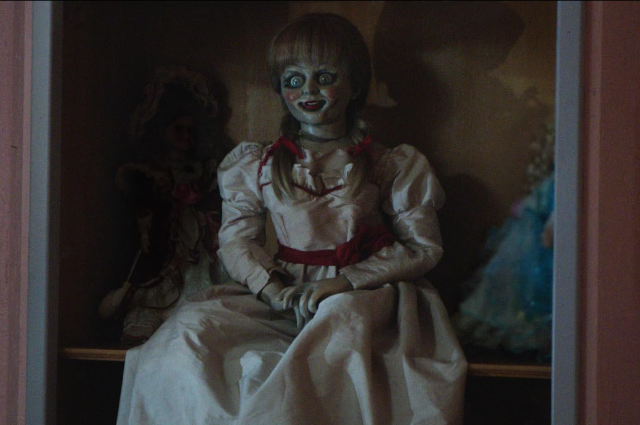Prologue: Gettysburg, July 2025
The ballroom was buzzing with anticipation. Rows of curious onlookers leaned forward as the curtains drew back, revealing her: Annabelle, the infamous doll that allegedly carries a demonic presence. She sat encased in glass, her stitched smile staring into the void—or into you, depending on where you stood.
Presiding over this traveling spectacle was Dan Rivera, a seasoned paranormal investigator, U.S. Army veteran, and trusted handler of the Warren family’s occult collection. Rivera was no stranger to darkness; for years, he’d told audiences the story of the doll that inspired horror franchises and sleepless nights. He laughed off rumors, spoke with reverence, and insisted on caution.
But just hours after the Gettysburg event on July 13, 2025, Rivera was found dead in his hotel room. The headlines wrote themselves:
“Handler of Haunted Doll Dies Suddenly.”
The coroner confirmed no foul play. Police stated the doll was not in his room. Officially, it was “a natural, unexpected death.” Unofficially? The whispers had already begun.
Did Annabelle claim another victim?
Chapter One: A Rag Doll with a Reputation
Long before social media hashtags and blockbuster franchises, Annabelle was just a gift. In the early 1970s, nursing student Donna received a Raggedy Ann doll from her mother—a soft-bodied toy with yarn hair and button eyes. Innocent. Forgettable.
Until it wasn’t.
The doll began to move. Not dramatically—no spinning heads or levitating theatrics—just subtle changes: arms positioned differently, a new spot on the couch. Enough to make you question memory, not reality.
Then came the notes. Slips of parchment—paper no one in the house owned—scribbled with childlike pleas: “HELP US” and “HELP LOU.”
Lou, Donna’s friend, soon bore the brunt of Annabelle’s attention. He reported waking to find the doll staring at him and, in one harrowing episode, felt unseen hands grip his throat as he lay paralyzed. Later, deep claw marks appeared across his chest—marks that vanished within days but left a scar on the mind.
Seeking answers, Donna invited a medium, who spun a tale of a little girl’s spirit—Annabelle Higgins, lonely and longing for love. Donna, compassionate and naive, granted permission for the spirit to “stay.” That yes was the worst mistake she ever made.
Chapter Two: The Warrens Step In
When Ed and Lorraine Warren entered the scene, they wasted no time debunking the “sad child” theory. This wasn’t innocence. This was deception.
The Warrens concluded the doll was a conduit—a vessel manipulated by an inhuman entity. Its endgame? Not friendship. Possession.
After a blessing and ritual cleansing, the doll was removed from Donna’s apartment. But the Warrens knew better than to toss it in a landfill. They took Annabelle home, locked her in a glass-fronted case, and scrawled a warning no sane person could misinterpret:
“Positively Do Not Open.”
And so Annabelle sat, in the Warren Occult Museum, her silence screaming louder than any banshee.
Chapter Three: Death, Curses, and Convenient Coincidences
Legends fermented around her. One man mocked the doll, banging on the case. Hours later, he died in a motorcycle crash. Clergy who doubted her power reported near-fatal accidents. Coincidence? Skeptics insist so. Believers call it the doll’s blood ledger.
Even locked away, Annabelle remained restless in headlines. Viral rumors claimed she escaped during 2020, spawning memes and panic. The museum closed in 2019, but the doll lived on—touring under NESPR’s watch, photographed under fluorescent lights, and whispered about in every dim-lit Reddit thread on cursed objects.
Chapter Four: The Rivera Tragedy
And then, decades later, the Rivera case breathed new life into the legend.
Rivera wasn’t a novice thrill-seeker. He was NESPR’s trusted point man, the bridge between believers and skeptics, the guardian of artifacts said to reek of Hell. His bond with Lorraine Warren was personal, forged through years of work and loyalty.
When his death hit the wires, explanations diverged. Officials cited sudden illness, a natural event. But in the theater of the paranormal, reason is just white noise against a darker melody.
Some insist Annabelle’s presence at the event tethered his fate. Others claim the doll carries a psychic contagion, punishing those who get too close. Snopes slapped “False” on the wilder theories, but folklore feeds on ambiguity. And in Rivera’s death, ambiguity drips like candle wax.
Chapter Five: Fact, Fiction, and the Fabric of Fear
So what’s the truth behind the threads? Here’s what the light reveals—and the shadows obscure:
The real Annabelle is a Raggedy Ann doll, not the porcelain terror from the films.
Every paranormal claim traces back to the Warrens. No independent documentation confirms supernatural activity.
The NESPR tours blur the line between preservation and performance—some call it exploitation, others, education.
Dan Rivera’s death was tragic—but causally tied to Annabelle? Science says no. Superstition says maybe.
Epilogue: Why Annabelle Endures
Annabelle is not just an artifact; she’s an idea stitched into cultural memory—a paradox of innocence and evil. She embodies our fear that the most harmless things hide the darkest secrets.
When the curtains close, and the last flash of a phone camera fades, she remains in her glass box, still smiling that stitched, senseless smile.
But if you lean in—just a little too close—you might feel it: the weight of a story that refuses to die.
After all, some things don’t just haunt the living. They perform.
And Annabelle? She’s still on tour.

